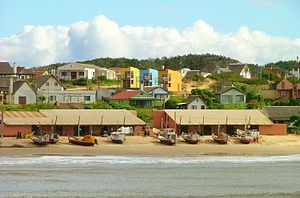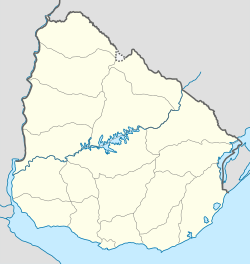Punta del Diablo facts for kids
Quick facts for kids
Punta del Diablo
|
|
|---|---|
|
Village, resort
|
|
 |
|
| Country | |
| Department | Rocha Department |
| Population
(2011)
|
|
| • Total | 823 |
| Time zone | UTC -3 |
| Postal code |
27204
|
| Area code(s) | +598 4477 |
| Climate | Cfa |
Punta del Diablo is a charming village and beach resort in Uruguay. It's located in the Rocha Department, about 298 kilometers (185 miles) east of the capital city, Montevideo.
In 2011, about 823 people lived there permanently. Many of them were fishermen or artisans (people who make things by hand). But during the busy summer season, the population can grow to around 25,000! Most visitors come from Argentina, Brazil, and Europe for holidays. Like the rest of Uruguay, the main language spoken in Punta del Diablo is Spanish. In 2008, "Lonely Planet" magazine called it one of the top 20 places to visit.
Contents
How Many People Live Here?
In 2011, Punta del Diablo had a population of 823 people. You can see how the population has grown over the years:
| Year | Population |
|---|---|
| 1985 | 199 |
| 1996 | 318 |
| 2004 | 389 |
| 2011 | 823 |
Source: National Institute of Statistics of Uruguay
Where is Punta del Diablo?
Punta del Diablo is about 298 kilometers (185 miles) from Montevideo, Uruguay's capital. It's also 172 kilometers (107 miles) from the fancy beach town of Punta del Este. The village is 43 kilometers (27 miles) from Chuy, a town right on the border with Brazil.
The village sits on a gentle hill overlooking the ocean. Its center has a square with brightly colored buildings. These include houses, shops, restaurants, and grocery stores. They are all along sandy paths.
There are no tall buildings or huge luxury resorts here. This is because of strict building rules. Instead, you'll find small hotels, cozy hostels, and vacation houses.
The beautiful white sand beaches are divided by rocky points. The main one is called "Punta Del Diablo." It stretches out more than 180 meters (600 feet). Two other rocky points join it to form "The Trident."
What's the Weather Like?
Punta del Diablo is in the southern part of the world, where the weather changes with the seasons. It has four distinct seasons.
In summer, temperatures usually range from 21 to 27 degrees Celsius (70 to 81 degrees Fahrenheit). In winter, they are typically between 10 and 16 degrees Celsius (50 to 61 degrees Fahrenheit).
Visiting Punta del Diablo
The busiest time for visitors is from December to February. This includes the week of Easter. During these months, the village's population grows a lot. It goes from about 400 permanent residents to around 25,000 people!
Visitors often rent homes or small cabins. They can also stay in hostels or small hotels. Many hotels and hostels are only open during the busy season. However, some stay open all year. This is because more and more people are visiting the village even when it's not summer. Some restaurants, including nice ones, also stay open year-round.
In 2008, Lonely Planet magazine said Punta del Diablo was one of the top 10 cities to visit. That year, about 20,000 tourists came during the peak season from December to February.
Punta del Diablo has become more and more popular with people on holiday. A single farming family used to own all the land here. Now, they have been selling land to people who want to invest. This growth in tourism and Uruguay's good investment rules attract people from other countries. Foreign investors are treated the same as local ones. They don't need special permission and can freely send money and profits home. Uruguay has about 100 American companies that have invested around $656 million. Punta del Diablo itself has attracted many American and other foreign investors.
Cool Places to See
- Beaches - The beautiful white sand beaches are a big reason people visit.
- Los Botes is called "Fisherman’s Beach." Most fishing boats leave from here.
- Rivero beach is lined with open bars during the busy season. It's popular with surfers.
- La Viuda beach is also a favorite for surfers. In summer, locals and visitors often gather around bonfires here. They play guitars and sing songs.
- Parque Nacional Santa Teresa (Saint Teresa National Park) - This coastal park is about 5 kilometers (3 miles) from Punta del Diablo. It covers 3,000 hectares (about 7,400 acres). It has about 2 million trees and plants and animals from all over the world. You might even see rare cormorants! This park was also the site of a major battle for Uruguay's independence. There are 60 kilometers (37 miles) of hiking trails. You can find sand dunes on the beaches. During Uruguay's summer, you might even see whales along the shore.
- Fortaleza de Santa Teresa (Fortress of Santa Teresa) - This is a very important historical place in Uruguay. The fortress sits on top of a hill inside Saint Teresa National Park. The Portuguese started building it in 1762. The Spanish took it over in 1793. It was built in an area that both empires wanted. This area now forms one of the oldest borders in the Americas. Its location was very important for armies coming from Brazil. The fortress was part of many battles. It was used by the Portuguese, Spanish, and later in civil wars after Uruguay became its own country. The fortress was fixed up in 1928. It now has a museum that shows its history. The fortress is also shown on the flag and shield of the Rocha department. It has become a symbol of this border region with Brazil.
- Laguna Negra (Black Lagoon) - This lake is also known as Laguna de los Difuntos. It's a great place for boating and watching birds. The lake and its swamps cover 182 square kilometers (70 square miles). It is about 5 meters (16 feet) deep at its deepest point.
- Bosque de Ombúes (Ombu Forest) - This forest is home to native Ombu trees. These are strong trees that don't need much water to survive. You can take jeep or tractor tours to see the forest. Visitors can also walk through it. The forest has plants and animals that are unique to this area.
- Centro de Tortugas Marinas (Center for Sea Turtles) - This center is located near where sea turtles often find food. These waters are off the beaches from Barra del Chuy to Punta del Diablo. The center teaches visitors about sea turtles. It also has a program where people can volunteer to help.
Fun Things to Do
- Horseback Riding. You can rent horses or go on guided horseback riding tours. These tours take you on the beach or through the forest. You can do this all year round.
- Dune Boarding. This is like snow boarding, but you do it on sand dunes! The surf shop in Punta del Diablo sells dune boards. A popular spot for dune boarding is the south end of La Viuda beach.
- Surfing. The waves off Punta del Diablo's beaches are usually good for surfing. They are also not too crowded. The best conditions are in autumn and winter. The busiest surfing time is from December to February. You can rent or buy surfboards at the Surf Shop on Main Road.
Getting Around
You can walk from one end of the town to the other in about an hour. There is a regular bus service that takes people from the main village road to the beach. There is also a taxi, which often waits at the bus stop.
Punta del Diablo has regular bus service to Chuy (on the border with Brazil), Rocha, and Montevideo. In the summer, you can also take buses to other beach towns like La Paloma, La Piedra, and Punta del Este. During the busiest time in January, bus seats can be booked days in advance.
You can rent cars in Montevideo if you need one.
When you arrive in Punta del Diablo, some buses go right into town. Others drop passengers off about 5 kilometers (3 miles) from town. From there, dirt roads lead to different parts of the village. The bus ride from Montevideo takes about 3 and a half hours.
See also
 In Spanish: Punta del Diablo para niños
In Spanish: Punta del Diablo para niños


